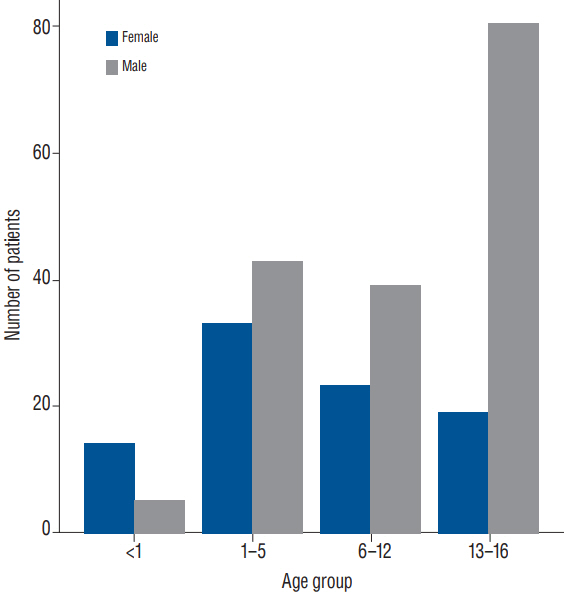J Korean Neurosurg Soc.
2017 Nov;60(6):710-716. 10.3340/jkns.2016.1010.001.
Mortality and Epidemiology in 256 Cases of Pediatric Traumatic Brain Injury: Korean Neuro-Trauma Data Bank System (KNTDBS) 2010–2014
- Affiliations
-
- 1Department of Neurosurgery, Chungnam National University Hospital, Daejeon, Korea. swchoi@cnu.ac.kr
- KMID: 2395791
- DOI: http://doi.org/10.3340/jkns.2016.1010.001
Abstract
OBJECTIVE
Among pediatric injury, brain injury is a leading cause of death and disability. To improve outcomes, many developed countries built neurotrauma databank (NTDB) system but there was not established nationwide coverage NTDB until 2009 and there have been few studies on pediatric traumatic head injury (THI) patients in Korea. Therefore, we analyzed epidemiology and outcome from the big data of pediatric THI.
METHODS
We collected data on pediatric patients from 23 university hospitals including 9 regional trauma centers from 2010 to 2014 and analyzed their clinical factors (sex, age, initial Glasgow coma scale, cause and mechanism of head injury, presence of surgery).
RESULTS
Among all the 2617 THI patients, total number of pediatric patients was 256. The average age of the subjects was 9.07 (standard deviation±6.3) years old. The male-to female ratio was 1.87 to 1 and male dominance increases with age. The most common cause for trauma were falls and traffic accidents. Age (p=0.007), surgery (p<0.001), mechanism of trauma (p=0.016), subdural hemorrhage (SDH) (p<0.001), diffuse axonal injury (DAI) (p<0.001) were statistically significant associated with severe brain injury.
CONCLUSION
Falls were the most common cause of trauma, and age, surgery, mechanism of trauma, SDH, DAI increased with injury severity. There is a critical need for effective fall and traffic accidents prevention strategies for children, and we should give attention to these predicting factors for more effective care.
Keyword
MeSH Terms
Figure
Cited by 1 articles
-
Pediatric Traumatic Brain Injury : The Epidemiology in Korea
Eun Suk Park, Hui-Jun Yang, Jun Bum Park
J Korean Neurosurg Soc. 2022;65(3):334-341. doi: 10.3340/jkns.2021.0306.
Reference
-
References
1. Berger MS, Pitts LH, Lovely M, Edwards MS, Bartkowski HM. Outcome from severe head injury in children and adolescents. J Neurosurg. 62:194–199. 1985.
Article2. Berney J, Favier J, Froidevaux AC. Paediatric head trauma: influence of age and sex. I Epidemiology Childs Nerv Syst. 10:509–516. 1994.
Article3. Duhaime AC, Alario AJ, Lewander WJ, Schut L, Sutton LN, Seidl TS, et al. Head injury in very young children: mechanisms, injury types, and ophthalmologic findings in 100 hospitalized patients younger than 2 years of age. Pediatrics. 90(2 Pt 1):179–185. 1992.
Article4. Ghajar J, Hariri RJ. Management of pediatric head injury. Pediatr Clin North Am. 39:1093–1125. 1992.
Article5. Giza CC, Mink RB, Madikians A. Pediatric traumatic brain injury: not just little adults. Curr Opin Crit Care. 13:143–152. 2007.
Article6. Goldsmith W, Plunkett J. A biomechanical analysis of the causes of traumatic brain injury in infants and children. Am J Forensic Med Pathol. 25:89–100. 2004.
Article7. Hawley CA, Ward AB, Long J, Owen DW, Magnay AR. Prevalence of traumatic brain injury amongst children admitted to hospital in one health district: a population-based study. Injury. 34:256–260. 2003.
Article8. Hyun DK, Ha YS, Park CO. A clinical analysis of pediatric head injuries. J Korean Neurosurg Soc. 30:54–59. 2001.9. Jalalvandi F, Arasteh P, Safari Faramani R, Esmaeilivand M. Epidemiology of pediatric trauma and its patterns in western iran: a hospital based experience. Glob J Health Sci. 8:139–146. 2016.
Article10. Jo HJ, Lim YS, Kim JJ, Cho JS, Hyun SY, Yang HJ, et al. Value of repeat brain computed tomography in children with traumatic brain injury. J Trauma Inj. 28:149–157. 2015.
Article11. Keenan HT, Bratton SL. Epidemiology and outcomes of pediatric traumatic brain injury. Dev Neurosci. 28:256–263. 2006.
Article12. Kim HB, Kim DK, Kwak YH, Shin SD, Song KJ, Lee SC, et al. Epidemiology of traumatic head injury in Korean children. J Korean Med Sci. 27:437–442. 2012.
Article13. Kim JK, Park JY, Cho TH, Kwon TH, Lim DJ, Chung YK, et al. Clinical features and prognostic factors of head injury in less than two-year-old children. J Korean Neurosurg Soc. 27:625–631. 1998.14. Lee KW, Hwang SK, Sung JK, Hamm IS, Park YM, Kim SL. Pediatric head injury. J Korean Neurosurg Soc. 28:42–47. 1999.15. Luerssen TG, Klauber MR, Marshall LF. Outcome from head injury related to patient’s age. A longitudinal prospective study of adult and pediatric head injury. J Neurosurg. 68:409–416. 1988.16. Mannix R, Monuteaux MC, Schutzman SA, Meehan WP 3rd, Nigrovic LE, Neuman MI. Isolated skull fractures: trends in management in US pediatric emergency departments. Ann Emerg Med. 62:327–331. 2013.
Article17. Margulies SS, Thibault KL. Infant skull and suture properties: measurements and implications for mechanisms of pediatric brain injury. J Biomech Eng. 122:364–371. 2000.
Article18. Park CO, Chae KB, Lee SD, Jeon HK, Kim Y, Ha YS. A clinical observation on head injuries in infants and children. J Korean Neurosurg Soc. 21:176–185. 1992.19. Prevention Centers for Disease Control and Prevention National Center for Injury Prevention and Contorl. Traumatic Brain Injury in the United States: Emergency Department Visits, Hospitalizations and Deaths 2002–2006 (Blue Book). Available from: http://www.cdc.gov/traumaticbraininjury/tbi_ed.html .20. Statistics Korea. Annual report on the causes of death statistics. Available from: http://kostat.go.kr/portal/korea/kor_nw/2/6/2/index.board?bmode=read&bSeq=&aSeq=348539&pageNo=1&rowNum=10&navCount=10&currPg=&sTarget=title&sTxt= .21. Trefan L, Houston R, Pearson G, Edwards R, Hyde P, Maconochie I, et al. Epidemiology of children with head injury: a national overview. Arch Dis Child. 101:527–532. 2016.
Article
- Full Text Links
- Actions
-
Cited
- CITED
-
- Close
- Share
- Similar articles
-
- Analysis of Mortality and Epidemiology in 2617 Cases of Traumatic Brain Injury : Korean Neuro-Trauma Data Bank System 2010–2014
- Epidemiology and Outcomes of Traumatic Brain Injury in Elderly Population : A Multicenter Analysis Using Korean Neuro-Trauma Data Bank System 2010–2014
- Comparison of Outcomes at Trauma Centers versus Non-Trauma Centers for Severe Traumatic Brain Injury
- Clinical and Radiological Characteristics of Traumatic Pneumocephalus after Traumatic Brain Injury
- Introduction to the Korean Neurotrauma Data Bank System and Report on the Results of the Second Project


